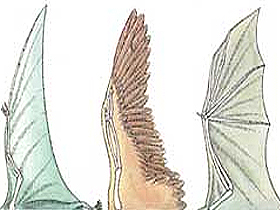Some organs superficially appear to be similar and perform the same function. For example, their wings allow butterflies and birds to fly; and both cats and beetles use their legs to walk. But these creatures have completely different genetic and anatomical structures. This kind of similarity is only superficial.20
 The wings of a flying reptile, a bird, and a bat. There can be no evolutionary relationship among them, yet these wings all have similar structures. |
Darwin stated that creatures with similar (so-called homologous) organs were related to one another by evolution, and that these organs must have been developed in some common ancestor. However, his assertion rests on no proof and was merely a supposition made on the basis of external similarities. From Darwin’s time until now, no solid evidence has been discovered to substantiate these assertions.
But many species among which evolutionists have been unable to establish an evolutionary connection do have similar (homologous) organs. The wing is the best known example. Bats, which are mammals, have wings and so do birds. Flies and many varieties of insects have wings, but evolutionists have not been able to establish any evolutionary connection or relationship among these various classes.
According to evolutionary theory, wings came to be by chance in four independent groups: in insects, flying reptiles, birds and bats. When evolutionists try to explain these four instances by the mechanisms of natural selection/mutation and assert a similarity of structure among them, biologists come up against a serious impasse.
Mammals are one of the most concrete examples that draw the evolutionary thesis into a blind alley. Modern biology accepts that all mammals are divided into two basic categories: those with placentas, and marsupials. Evolutionists suppose that this difference came into existence with the first mammals and that each category underwent a different evolutionary history, independently of the other. But it is interesting that in each of these two categories, there are almost two “identical pairs”. Wolves, cats, squirrels, anteaters, moles and mice with their similar features belong both to the category of mammals with placentas and marsupials.21 In other words, according to the theory of evolution, totally independent mutations must have produced these two categories of creatures by chance! Of course, this is impossible.
One of the interesting similarities between placental mammals and marsupials is that between the North American wolf and the Tasmanian wolf. The first is classed as a mammal with a placenta; the second as a marsupial. (It is supposed that contact between marsupials and placental was severed when Australia and its costal islands separated from the continent of Antarctica—and that there were no species of wolves at that time.)
But structurally, that the skeletons of the North American wolf and the Tasmanian wolf are almost identical. As the above illustration shows, their skulls match almost exactly.
Such similarities, which evolutionist biologists cannot accept as examples of homology, demonstrate that similar organs do not prove the thesis of evolution from a common ancestor.
  The Tasmanian Wolf and a Similar Animal from North America The existence of twin species between pouched and placental mammals is a serious blow to the homological claim. For example, the placental wolf from North America and the pouched Tasmanian wolf above bear an extraordinary resemblance to one another. To the side can be seen the two species’ very similar skulls. Such a close similarity between these two, for which no evolutionary relationship can be claimed, leaves the homological claim totally unfounded. |
21 Dean Kenyon, Davis Percical, Of Pandas and People: The Central Question of Biological Origins, Dallas: Haughton Publishing, 1993, p. 33.


